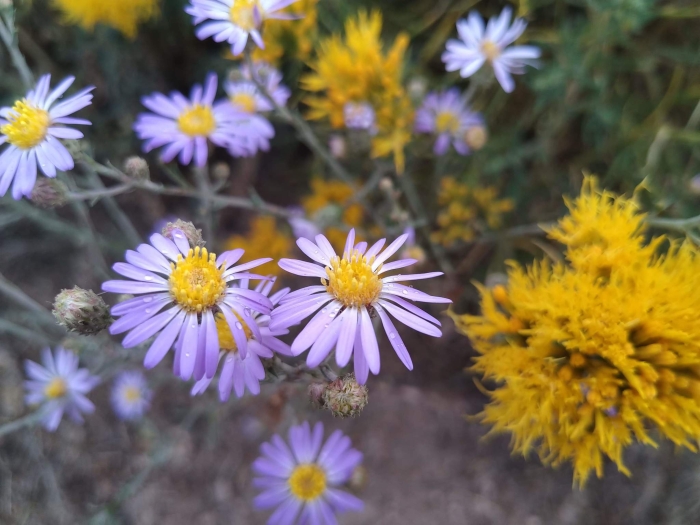Hoary Tansyaster
(Dieteria canescens)
Hoary Tansyaster (Dieteria canescens)
/
/

Viktoriia Streltsova
CC BY 4.0
Image By:
Viktoriia Streltsova
Recorded By:
Copyright:
CC BY 4.0
Copyright Notice:
Photo by: Viktoriia Streltsova | License Type: CC BY 4.0 | License URL: http://creativecommons.org/licenses/by/4.0/ | Rights Holder: Viktoriia Streltsova | Publisher: iNaturalist | Date Created: 2019-09-04T10:25Z |


















































Estimated Native Range
Summary
Dieteria canescens, commonly known as Hoary Tansyaster, is a perennial herb native to arid and semi-arid regions, including prairies, dry open woods, and scrublands in the Western United States and Canada. It typically grows to a height of 1-2 feet and can spread to a width of 4-6 feet. The plant forms a bushy clump with narrow, gray-green leaves and stems that are covered in fine hairs, giving it a hoary appearance. From late summer to fall, it produces numerous daisy-like flowers with yellow centers and purple to lavender rays, which are quite showy and attract a variety of pollinators.
Hoary Tansyaster is valued for its drought tolerance and its ability to thrive in poor soils, making it an excellent choice for xeriscaping and naturalized areas. It is also used in wildflower gardens, as a border plant, and for restoration projects. This plant is adapted to full sun or part shade and prefers well-drained soils. While it is generally low-maintenance, it can benefit from occasional watering during prolonged dry spells. There are no major disease or pest issues, but it can occasionally suffer from root rot if overwatered.CC BY-SA 4.0
Hoary Tansyaster is valued for its drought tolerance and its ability to thrive in poor soils, making it an excellent choice for xeriscaping and naturalized areas. It is also used in wildflower gardens, as a border plant, and for restoration projects. This plant is adapted to full sun or part shade and prefers well-drained soils. While it is generally low-maintenance, it can benefit from occasional watering during prolonged dry spells. There are no major disease or pest issues, but it can occasionally suffer from root rot if overwatered.CC BY-SA 4.0
Plant Description
- Plant Type: Herb
- Height: 1-2 feet
- Width: 4-6 feet
- Growth Rate: Moderate
- Flower Color: Purple
- Flowering Season: Summer, Fall
- Leaf Retention: Deciduous
Growth Requirements
- Sun: Full Sun, Part Shade
- Water: Low
- Drainage: Medium, Fast
Common Uses
Bee Garden, Bird Garden, Butterfly Garden, Hummingbird Garden, Low Maintenance, Rock Garden, Showy Flowers
Natural Habitat
Arid and semi-arid regions, including prairies, dry open woods, and scrublands
Other Names
Common Names: Hoary-Aster, Canescent Aster, Hoary Aster, Hoary Tansy-Aster, Aster Chenu
Scientific Names: , Machaeranthera canescens, Dieteria canescens, Aster canescens, Machaeranthera ramosa, Aster canescens var. viscosus, Machaeranthera glabella, Machaeranthera linearis, Machaeranthera spinulosa, Machaeranthera canescens var. monticola
GBIF Accepted Name: Dieteria canescens (Pursh) Nutt.